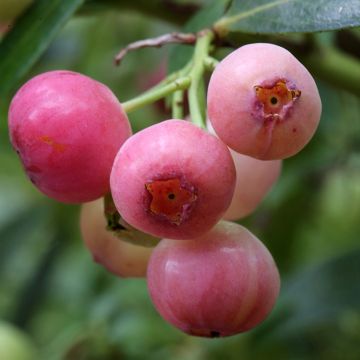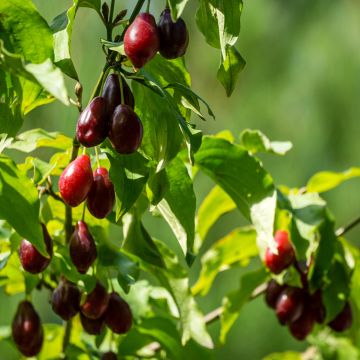

Vaccinium corymbosum Hortblue Poppins
Vaccinium corymbosum Hortblue Poppins
Vaccinium corymbosum Hortblue Poppins®
American blueberry, highbush blueberry, swamp blueberry, tall huckleberry
Special offer!
Receive a €20 voucher for any order over €90 (excluding delivery costs, credit notes, and plastic-free options)!
1- Add your favorite plants to your cart.
2- Once you have reached €90, confirm your order (you can even choose the delivery date!).
3- As soon as your order is shipped, you will receive an email containing your voucher code, valid for 3 months (90 days).
Your voucher is unique and can only be used once, for any order with a minimum value of €20, excluding delivery costs.
Can be combined with other current offers, non-divisible and non-refundable.
Home or relay delivery (depending on size and destination)
Schedule delivery date,
and select date in basket
This plant carries a 6 months recovery warranty
More information
We guarantee the quality of our plants for a full growing cycle, and will replace at our expense any plant that fails to recover under normal climatic and planting conditions.
Description
The Vaccinium corymbosum 'Hortblue Poppins' is a self-fertile variety of blueberry bush originating in Aotearoa New Zealand, with large, firm, tangy and tasty fruits. It is mid-season, and the blueberries can be harvested from mid-July onwards. They tolerate heat well and remain attached to the bush. In winter, this compact bush tolerates cold and snow, and can be planted at high altitudes. This bush requires a moist to wet, well-drained and acidic soil, in mild sun or partial shade.
The Vaccinium corymbosum or American blueberry belongs, like rhododendrons, heathers and andromedas, to the large Ericaceae family. In the vast majority of cases, these species prefer a rather moist and, above all, acidic soil. The presence of limestone in the soil quickly causes them to turn yellow and wither. The Vaccinium corymbosum is an irregular and bushy shrub, reaching about 1.50 m (5ft) in height and width. In May-June, it produces numerous melliferous white bell-shaped flowers, which will give rise a few weeks later to the famous dark blue, slightly powdery blueberries, gathered in abundant clusters. The fruits are less intensely flavored than our European blueberries, but they are much larger, with a diameter of up to 1 cm (<1in). These are the ones that are most often found in commerce, as they are cultivated on a large scale. However, they are rich in nutrients and antioxidants. The leaves are deciduous, lanceolate, and in autumn they take on superb, very vivid colours ranging from scarlet red to yellow and orange.
The 'Hortblue Poppins' variety, taller than it is wide, is compact, reaching a height of 1.80 m (6ft) and a width of 1.5 m (5ft) at maturity. It is self-fertile, but its production will be improved by the presence of several blueberry plants. After flowering in May, the plant bears fruit for harvesting in mid-July. The yield in the first few years is not optimal, so it needs time to establish itself. 'Hortblue Poppins' is one of the first varieties tested in the lab for its resistance to anthracnose and botrytis. The fruits are of good size and covered with a beautiful bloom. The skin is quite thick and the texture is firm, with a balanced taste.
Plant the 'Hortblue Poppins' blueberry bush in a soil without limestone. Ericaceous soil mixes can be used to correct a soil that is too heavy, compact, and clayey, but do not expect good results in a soil that is too far from the required conditions. Provide it with a sheltered location, in light shade. It is hardy down to -25°C (-13°F). Plant 2 or 3 plants of the same variety or different varieties for a more abundant harvest. Consume its fruits raw or cooked, in jams or pies.
The 'Hortblue Poppins' Vaccinium can be planted in a vegetable garden or edible garden. Its beautiful autumn colours can also be enjoyed in an ornamental garden by pairing it with plants that have the same requirements, in a mass planting of heather soil with hydrangeas, pieris or azaleas.
Report an error about the product description
Plant habit
Fruit
Flowering
Foliage
Botanical data
Vaccinium
corymbosum
Hortblue Poppins®
Ericaceae
American blueberry, highbush blueberry, swamp blueberry, tall huckleberry
Cultivar or hybrid
Other Blueberry bush
View all →Planting and care
If the soil suits it, the American Blueberry is a plant that will grow and bear fruit on its own. Install it in an acidic soil (pH between 4 and 5.5), pure ericaceous soil or a mixture of ordinary soil and well-decomposed pine-bark compost. In limestone soil, it is necessary to dig a pit 50 to 60 cm (20 to 24in) deep, line the edges with a garden felt, place a non-limestone gravel bed 10 cm (4in) thick at the bottom, then fill with an acidic soil mixture. The soil must remain moist, but without stagnant humidity. If watering is necessary, it should be done with non-limestone and non-chlorinated water. This bush likes filtered light, especially if it lives in a region with hot summers. It must be protected from dry winds and high temperatures. Mulch the base with shredded bark, straw, or fern leaves. From the third year, apply a rhododendron fertiliser in autumn, and ammonium sulfate in spring.
Planting period
Intended location
Care
This item has not been reviewed yet - be the first to leave a review about it.
Similar products
Haven't found what you were looking for?
Hardiness is the lowest winter temperature a plant can endure without suffering serious damage or even dying. However, hardiness is affected by location (a sheltered area, such as a patio), protection (winter cover) and soil type (hardiness is improved by well-drained soil).

Photo Sharing Terms & Conditions
In order to encourage gardeners to interact and share their experiences, Promesse de fleurs offers various media enabling content to be uploaded onto its Site - in particular via the ‘Photo sharing’ module.
The User agrees to refrain from:
- Posting any content that is illegal, prejudicial, insulting, racist, inciteful to hatred, revisionist, contrary to public decency, that infringes on privacy or on the privacy rights of third parties, in particular the publicity rights of persons and goods, intellectual property rights, or the right to privacy.
- Submitting content on behalf of a third party;
- Impersonate the identity of a third party and/or publish any personal information about a third party;
In general, the User undertakes to refrain from any unethical behaviour.
All Content (in particular text, comments, files, images, photos, videos, creative works, etc.), which may be subject to property or intellectual property rights, image or other private rights, shall remain the property of the User, subject to the limited rights granted by the terms of the licence granted by Promesse de fleurs as stated below. Users are at liberty to publish or not to publish such Content on the Site, notably via the ‘Photo Sharing’ facility, and accept that this Content shall be made public and freely accessible, notably on the Internet.
Users further acknowledge, undertake to have ,and guarantee that they hold all necessary rights and permissions to publish such material on the Site, in particular with regard to the legislation in force pertaining to any privacy, property, intellectual property, image, or contractual rights, or rights of any other nature. By publishing such Content on the Site, Users acknowledge accepting full liability as publishers of the Content within the meaning of the law, and grant Promesse de fleurs, free of charge, an inclusive, worldwide licence for the said Content for the entire duration of its publication, including all reproduction, representation, up/downloading, displaying, performing, transmission, and storage rights.
Users also grant permission for their name to be linked to the Content and accept that this link may not always be made available.
By engaging in posting material, Users consent to their Content becoming automatically accessible on the Internet, in particular on other sites and/or blogs and/or web pages of the Promesse de fleurs site, including in particular social pages and the Promesse de fleurs catalogue.
Users may secure the removal of entrusted content free of charge by issuing a simple request via our contact form.
The flowering period indicated on our website applies to countries and regions located in USDA zone 8 (France, the United Kingdom, Ireland, the Netherlands, etc.)
It will vary according to where you live:
- In zones 9 to 10 (Italy, Spain, Greece, etc.), flowering will occur about 2 to 4 weeks earlier.
- In zones 6 to 7 (Germany, Poland, Slovenia, and lower mountainous regions), flowering will be delayed by 2 to 3 weeks.
- In zone 5 (Central Europe, Scandinavia), blooming will be delayed by 3 to 5 weeks.
In temperate climates, pruning of spring-flowering shrubs (forsythia, spireas, etc.) should be done just after flowering.
Pruning of summer-flowering shrubs (Indian Lilac, Perovskia, etc.) can be done in winter or spring.
In cold regions as well as with frost-sensitive plants, avoid pruning too early when severe frosts may still occur.
The planting period indicated on our website applies to countries and regions located in USDA zone 8 (France, United Kingdom, Ireland, Netherlands).
It will vary according to where you live:
- In Mediterranean zones (Marseille, Madrid, Milan, etc.), autumn and winter are the best planting periods.
- In continental zones (Strasbourg, Munich, Vienna, etc.), delay planting by 2 to 3 weeks in spring and bring it forward by 2 to 4 weeks in autumn.
- In mountainous regions (the Alps, Pyrenees, Carpathians, etc.), it is best to plant in late spring (May-June) or late summer (August-September).
The harvesting period indicated on our website applies to countries and regions in USDA zone 8 (France, England, Ireland, the Netherlands).
In colder areas (Scandinavia, Poland, Austria...) fruit and vegetable harvests are likely to be delayed by 3-4 weeks.
In warmer areas (Italy, Spain, Greece, etc.), harvesting will probably take place earlier, depending on weather conditions.
The sowing periods indicated on our website apply to countries and regions within USDA Zone 8 (France, UK, Ireland, Netherlands).
In colder areas (Scandinavia, Poland, Austria...), delay any outdoor sowing by 3-4 weeks, or sow under glass.
In warmer climes (Italy, Spain, Greece, etc.), bring outdoor sowing forward by a few weeks.
















































